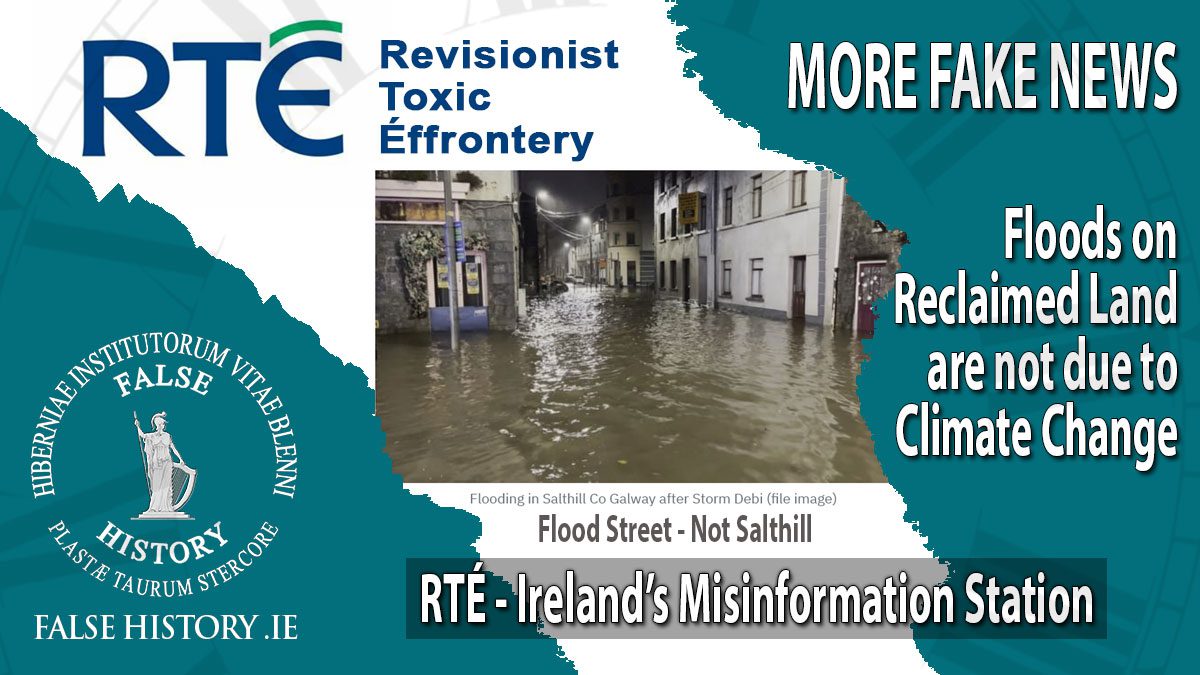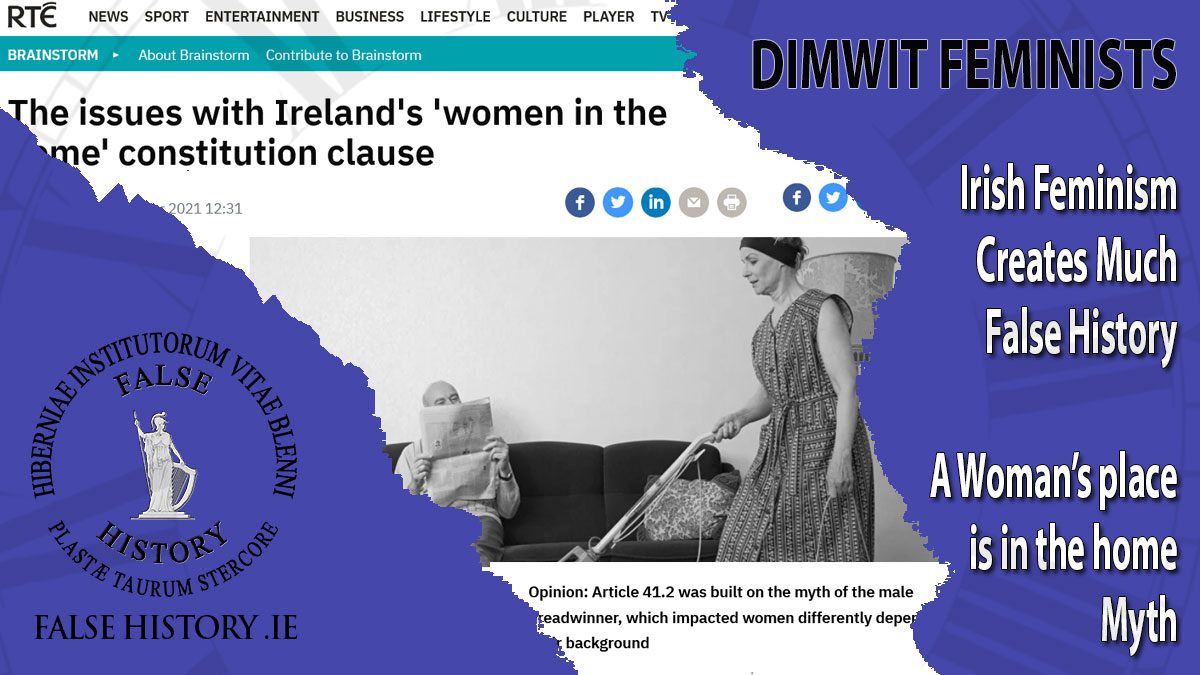Recent flood events at Salthill in Galway were reported under the headline “Storm Debi: Further sign of climate change in Ireland”. However, the floods have nothing to do with climate in Ireland or elsewhere. Caught out by history, RTÉ failed to report that all the areas of Galway hit by floods were reclaimed from the sea.
The article was written by George Lee, RTÉ’s Environment Correspondent, who was famously lampooned by satirists playing on his tendency towards excitability. However, his reputation as a prophet of doom dates from a decade earlier when working as the station’s economics correspondence. Then in 2018, perhaps in recognition of these qualities, the RTÉ authorities moved him from agriculture to environment as he would naturally take to climate alarmism, like a duck to water.
Reclaimed land is prone to subsidence (downward movement or sinking) over time as the ground dries out, leading to system compaction due to water withdrawal and natural compaction.
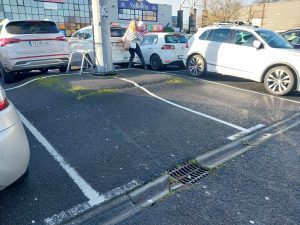 Here is a photo showing the foundations of a lamp post that were once level with the surrounding tarmac. Built on marshland that was once part of the river Corrib, the buildings of the Galway Retail Park all stand on piles. Those are tall pillars of reinforced concrete driven into the marsh until they reach solid ground underneath. A concrete foundation is then poured flat on top of the piles to ensure that the building does not sink.
Here is a photo showing the foundations of a lamp post that were once level with the surrounding tarmac. Built on marshland that was once part of the river Corrib, the buildings of the Galway Retail Park all stand on piles. Those are tall pillars of reinforced concrete driven into the marsh until they reach solid ground underneath. A concrete foundation is then poured flat on top of the piles to ensure that the building does not sink.
 The car park is not supported by piles, as it would be too expensive for such a large area and unnecessary. The engineers, in anticipation of land subsidence, designed the footpaths using cobble lock bricks, so that they could be easily taken up and re-laid as the ground settles. The second photo shows bricks pointing upward at a strange angle.
The car park is not supported by piles, as it would be too expensive for such a large area and unnecessary. The engineers, in anticipation of land subsidence, designed the footpaths using cobble lock bricks, so that they could be easily taken up and re-laid as the ground settles. The second photo shows bricks pointing upward at a strange angle.
The whole article shows a lack of care diligence for accurate reporting. Glaring errors are visible all through. One caption, “Flooding in Salthill in Co. Galway after Storm Debie”, is placed beneath a photograph of floods on Flood Street in Galway City centre, 1.5km from Salthill. One has only to look at the ESB mini pillars to observe they are double the height of normal installations. Why? Because Flood Street floods regularly and has flooded many times before ‘climate change’ became a popular phrase. The street stands on reclaimed land beside the old city port, which was also filled in to make the space for the town’s fish market.
RTÉ and many other news publishers are guilty of lying through omission. Not one of them mentioned the name Flood St., which we can surmise was due to the fear that readers might twig that its flooding has nothing got to do with climate change.
The carpark at Toft Park in Salthill features prominently when it floods in in publications eager to use it as evidence of something new in our climate. There are always cars left in the carpark, even when floods are expected. Accordingly, it delivers great photos and sends the subliminal message that the expected flooding was unexpected. However, either the car owners are clever people who have left their clapped-out bangers there in the expectation of receiving compensation from Galway City Council or they are total numpties.
The carpark sits on a mound of rubble dumped onto the seabed to create extra land. In the late 1960s and early 70s a dyke was constructed with a road sitting on top of it, taking a triangle of land from the sea. Over the course of a few years, rubble was dumped on this triangle to create land, which was later named Toft Park, to commemorate Claude Toft, a prominent Salthill businessman.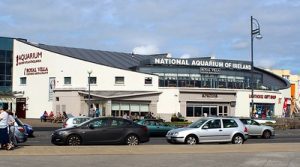
The land was used to construct a Tourist Office building and the National Aquarium beside it. In my memory, none of these buildings have ever flooded. The latter building is engineered to avoid flooding, as it is raised about a meter above its own car park.
Right next to it is the infamous carpark that floods every time when high winds combine with high tides to send waves crashing over the dyke. I suspect a secondary cause arises from the rainwater drains within the carpark. They may have no one-way valves and therefore permit water to backflow directly from the sea.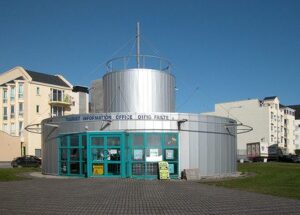 The old saying that ‘there is money in muck’ can be repurposed for present day use as ‘there is money in muckraking’. Many academics, keen to secure finance for their various projects have also used the floods in Galway for self-promotion.
The old saying that ‘there is money in muck’ can be repurposed for present day use as ‘there is money in muckraking’. Many academics, keen to secure finance for their various projects have also used the floods in Galway for self-promotion.
Tom McDermott of University of Galway has an article on RTE’s website advocating for his flood alarm system. According to him, it is a complex task to study all interactions between the various drivers of flood risk. There is no doubt that the academics will be kept in clover mulling over the complications of complicated systems. However, seldom do academics see or propose practical solutions.
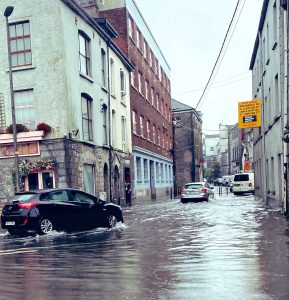 The solution for Toft Park is simple and very cost effective. Raise the level of the carpark. No more flooding, no more using it to create climate alarmism or fake news. The same solution is the only practical option for Flood Street. Raise the level of the dyke wall at the old Fishmarket/Spanish Arch. The solution is again simple, but simple solutions continue to evade Galway City Council. Rather than find a permanent solution, they continue to deploy a temporary dam in the form of a water filled tube along the same dyke or quay wall, in response to weather forecasts. Storm Debi caught them napping, and Flood St lived up to its name, with no flood defence in position.
The solution for Toft Park is simple and very cost effective. Raise the level of the carpark. No more flooding, no more using it to create climate alarmism or fake news. The same solution is the only practical option for Flood Street. Raise the level of the dyke wall at the old Fishmarket/Spanish Arch. The solution is again simple, but simple solutions continue to evade Galway City Council. Rather than find a permanent solution, they continue to deploy a temporary dam in the form of a water filled tube along the same dyke or quay wall, in response to weather forecasts. Storm Debi caught them napping, and Flood St lived up to its name, with no flood defence in position.
The current bunch of officials at Galway City Council have no memory of the city’s reclaimed lands, therefore have a complete lack of knowledge about how to manage or use such lands. Infamously, their lack of knowledge has bitten them on several occasions, but perhaps the most embarrassing incident occurred in February 2020. The opening ceremony for Galway, as the European City of Culture 2020 had to be cancelled due to flooding and high winds at the park.
The council scheduled the event to take place at South Park, a peninsula of land surrounded by the waters of the Corrib estuary and Galway Bay. The park is known locally as ‘The Swamp’ and is entirely made from reclaimed land. Parts of it were originally the seabed, but it was mostly a sea marsh that flooded at the time of spring tides. The land was first filled with the waste from the city, making it the city dump. It was later covered with topsoil and used as football pitches.
The old maps show a lake in the middle of the present park, fed by streams that in turn emptied into the Corrib estuary. These seem to have been covered up and blocked up, but sporadically the lake makes an appearance. It was there in February 2020 and has appeared several times since, most recently during storm Debi.
The June 2023 meeting of Galway City Councillors was reported under the headline, ‘Meeting hears no easy fix to serious flooding at South Park pitches’. However, the comments made indicated that the while the council are aware that the park is built on a dump, it thinks that the way to fix the problem is to dig it up and put in drainage pipes. A solution bound to fail because of false assumptions. Yes, it might keep the lake from reappearing or disappearing more quickly than it would do normally, but it does nothing to address the real issue, subsidence. The most practical solution is to raise the level of the ground. There is no need to break the current surface. Just lay drainage pipes on a membrane, cover over with gravel and layer over with topsoil.
The big argument of the climate change debate is its anthropogenic causes. Anthropogenic means human made, and the primary cause of flooding is Galway is most defiantly anthropogenic. It has nothing to do with climate change and everything to do with poor memory, poor planning, duff engineering, non-existent complexity, along with the complete absence of critical thinking and common sense.
The most troubling aspect of this fake news and poor-quality reportage is its use to scaremonger people, especially the young, into believing that the world is coming to an end.
The prophets of doom seek to profit from spreading doom, racing to outdo one another in the popularity stakes with no care for truth or quality. All our institutions have become corrupted by confirmation bias.
Looking only for evidence which confirms one’s opinion is a natural tendency and the biggest obstacle to rational thinking. Consequently, critical thinking and the scientific method both demand the that procedures are followed to combat confirmation bias. The first step is to seek out contrarian views to examine, analyse, count, or discount their veracity.
It is a supreme irony; that much of what is claimed to be based on science is not science or is just plain old bad science.
The climate change debate is riddled with bad science and bad actors.
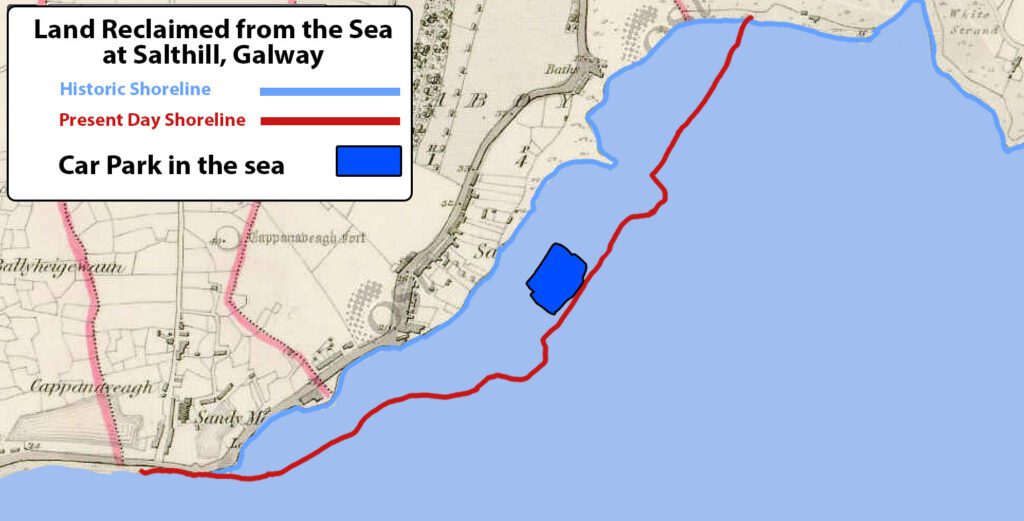
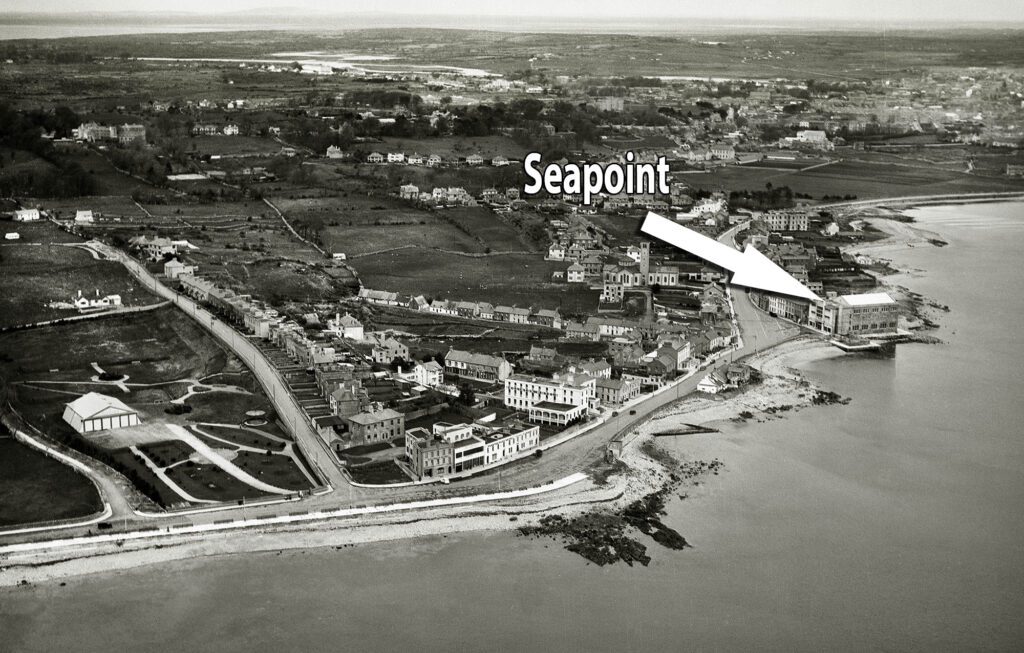

Refs
Storm Debi: Further sign of climate change in Ireland – By George Lee Environment Correspondent, in Dubai
Experts explore flooding South Park to combat rising sea levels (Photo of the swamp lake)
What’s required for local areas in Ireland to predict and anticipate floods?
Storm Debi: Galway playground and pitches among damaged facilities as financial help announced
